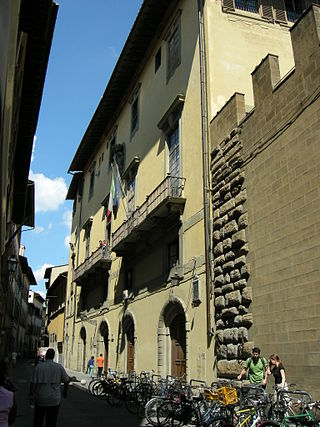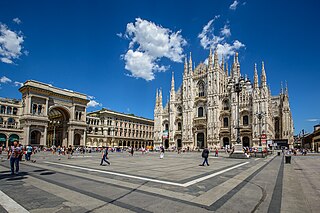
Pellegrino Tibaldi, also known as Pellegrino di Tibaldo de Pellegrini, was an Italian mannerist architect, sculptor, and mural painter.

The Pinacoteca di Brera is the main public gallery for paintings in Milan, Italy. It contains one of the foremost collections of Italian paintings from the 13th to the 20th century, an outgrowth of the cultural program of the Brera Academy, which shares the site in the Palazzo Brera.

Palazzo Brera or Palazzo di Brera is a monumental palace in Milan, in Lombardy in northern Italy. It was a Jesuit college for two hundred years. It now houses several cultural institutions including the Accademia di Brera, the art academy of the city, and its gallery, the Pinacoteca di Brera; the Orto Botanico di Brera, a botanical garden; an observatory, the Osservatorio Astronomico di Brera; the Istituto Lombardo Accademia di Scienze e Lettere, a learned society; and an important library, the Biblioteca di Brera.

Joseph Allegranza, pen name sometimes Rosario Maria Eulabio, was a Dominican historian, archaeologist and antiquary known for cataloguing the collection of Count Carlo Pertusati, now the Biblioteca di Brera.

The Accademia di Belle Arti di Brera, also known as the Accademia di Brera or Brera Academy, is a state-run tertiary public academy of fine arts in Milan, Italy. It shares its history, and its main building, with the Pinacoteca di Brera, Milan's main public museum for art. In 2010 an agreement was signed to move the accademia to a former military barracks, the Caserma Magenta in via Mascheroni. In 2018 it was announced that Caserma Magenta was no longer a viable option, with the former railway yard in Via Farini now under consideration as a potential venue for the campus extension.

Giuseppe Piermarini was an Italian architect who trained with Luigi Vanvitelli in Naples and designed the Teatro alla Scala in Milan (1776–78), which remains the work by which he is remembered. Indeed, il Piermarini serves as an occasional journalistic synonym for the celebrated opera house. Piermarini was appointed professor in the Academy of Fine Arts of Brera, better known as Brera Academy, Milan, when it was formally founded in 1776.

San Fedele is a Jesuit church in Milan, northern Italy. It is dedicated to St. Fidelis of Como, patron of the Catholic diocese of Como. Presently it remains a parish church, owned by the Jesuit order, though focusing on religious works.
The Esperanto National Library and Archive is the biggest Esperanto library in Italy; it is located in Massa, in northern Tuscany.

The Biblioteca Riccardiana is an Italian public library under the aegis of the Ministry of Culture, located inside the Palazzo Medici Riccardi at 10 Via de’ Ginori in Florence, in the neighborhood comprising the Mercato Centrale and the Basilica di San Lorenzo. Its main feature is preserving books collected by members of the Riccardi family and making them available in the very same rooms that were originally dedicated to that purpose. So, still today the library boasts the magnificent bookshelves, neatly carved and gilded, that create the atmosphere of a late-seventeenth-century patrician library, whose main features have all been kept intact.

The Biblioteca Palatina or Palatina Library was established in 1761 in the city of Parma by Philip Bourbon, Duke of Parma. It is one of the cultural institutions located in the Palazzo della Pilotta complex in the center of Parma. The Palatina Library was named after Apollus Palatinus.
Carlo Bassi was an Italian entomologist.

The Italian city of Milan is one of the international tourism destinations, appearing among the forty most visited cities in the world, ranking second in Italy after Rome, fifth in Europe and sixteenth in the world. One source has 56% of international visitors to Milan are from Europe, 44% of the city's tourists are Italian, and 56% are from abroad. The most important European Union markets are the United Kingdom (16%), Germany (9%) and France (6%). Most of the visitors who come from the United States to the city go on business matters, while Chinese and Japanese tourists mainly take up the leisure segment.

Emilio Sommariva was an Italian painter and photographer.

The Zone 1 of Milan, since 2016 officially Municipality 1 of Milan, is one of the 9 administrative divisions of Milan, Italy.
The Biblioteca Europea di Informazione e Cultura is an ongoing project based in Milan, Italy for the realization of a new modern library. It began in the late 1990s, when Antonio Padoa-Schioppa submitted the idea for the first time to the City of Milan and the Italian Ministry of Cultural Heritage and Activities and Tourism. The library is split in two main units: physical and virtual.

The following outline is provided as an overview of and topical guide to Milan:

The Biblioteca Chelliana is a public library in Grosseto, Italy, founded in 1860 by Giovanni Chelli. In 1865 it became a public library as Biblioteca comunale Chelliana. It currently occupies the Palazzo Mensini built in 1898.














